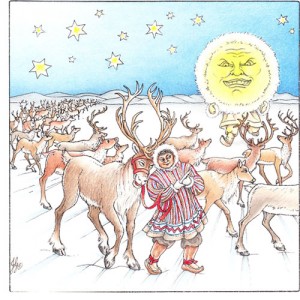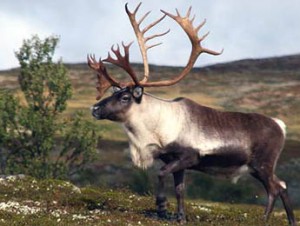Reindeer domestication is an interesting process. In some ways, it is very similar to the process of domestication for other animals, such as the horse, but in many ways, it is very different. The results of domestication are also different in many respects for reindeer. Domestication is an interesting process that only becomes more interesting when reindeer come into the picture.
Domestication, in a basic sense, is a process by which humans control the breeding and movement of a species of animal. The animal must also lose its fear of humans and be willing to be exposed to humans regularly (Clutton-Brock 3). Reindeer make this image of domestication problematic. Humans do not control the movement of domesticated reindeer. On the contrary, humans followed and continue to follow the migration routes of domesticated reindeer. Control over the breeding of reindeer is also somewhat tenuous. Interbreeding between wild and domesticated populations of reindeer are frequent because humans do not usually fence in domestic reindeer herds (Vitebsky 25).
According to Clutton-Brock, domestication also leads to genetic differences between the domesticated species and its wild counterparts. There is very little difference between domestic reindeer and wild reindeer. One study found that domestic reindeer are genetically distinct from wild reindeer, but much less so than other domesticates. Reindeer in a geographic area frequently interbreed regardless of whether they are wild or domestic, but rarely breed with reindeer in other geographic areas. This has led to genetically distinct reindeer in different geographic areas (Roed, et al. 1850-1853). Most domesticated animals are distinct species from their wild forebears, but wild and domesticated reindeer are not two distinct species. They share the same species name Ragnifer tarandus (Clutton-Brock 5).
Domestication also results in several phenotypic differences between the domesticated species and the wild species. Domesticated species tend to be smaller in size and have different coloration patterns, among other things. Reindeer exhibit this trend somewhat. Domesticate reindeer tend to be slightly smaller than wild reindeer and have slightly different color patterns, but for the most part, wild and domesticated reindeer are remarkably similar in how they look (Smith 68-69).
The origins of reindeer domestication are hard to definitively pin down, but they appear to be similar to other domesticates. Two myths from the Eveny people of Siberia point to reindeer domestication starting as a mutually beneficial relationship between reindeer and humans. In one myth, the first reindeer to be domesticated was attracted to the salt in human urine. A human used this to lure the reindeer closer and closer to the human camp until the reindeer was used to the closeness to humans and allowed the humans to milk it. Thus, the first reindeer was domesticated (Vitebsky 26). This seems like a likely scenario because a reindeer’s diet during the winter is mineral deficient and reindeer have been known to lick human urine as a way to get the salt they need to survive. It is at least possible that reindeer domestication arose out of a mutually beneficial relationship based in part on human urine (Smith 54-55).

An illustration from a folktale in which reindeer help create the seasons
http://www.weingartdesign.com/TMaS/Stories/images/ReindeerMaiden.jpg
Another Siberian myth describes how the first reindeer was birthed from a tree with the help of a passing human. This reindeer went on to have offspring, and the entire reindeer family was attacked by wolves. The younger reindeer fought off the wolf, while the older reindeer called for help from the god of nature, Hövki. Hövki sent the older reindeer to live with humans, who could protect them from wolves in exchange for their services. This presents an interesting idea of domestication, in that the reindeer chose to become domesticated, it was not an effort by humans to control the reindeer. This is, of course, just a folktale, not a definitive historical account, but the fact that this idea exists is significant. It leads to the idea that humans could have taken a more passive role in domestication the reindeer than in the horse, or other domesticate (Vitebsky 26).

